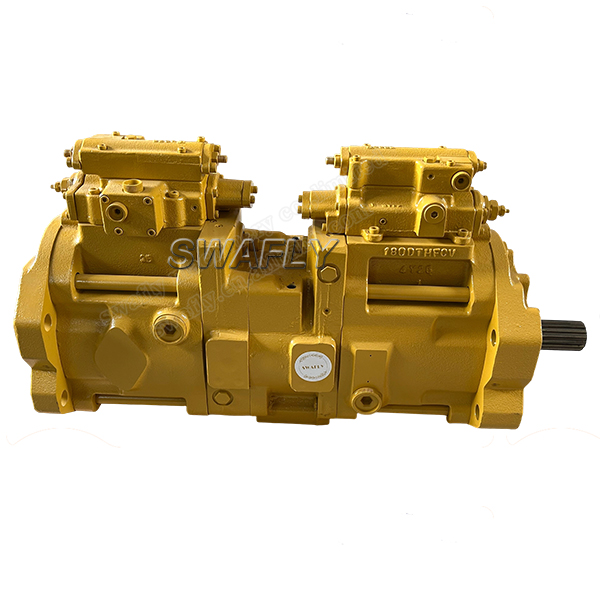Hydraulic Pumps: The Heart of Hydraulic Systems
2025-04-10
In the world of machinery and industrial applications, hydraulic pumps play a crucial role in converting mechanical energy into fluid power. These pumps are at the core of many systems, ranging from construction equipment and agricultural machinery to aircraft and manufacturing plants. Whether you’re lifting heavy loads, controlling robotic arms, or operating a simple hydraulic jack, hydraulic pumps make it all possible.
But what exactly are hydraulic pumps, how do they work, and why are they so essential in modern industries? Let’s explore the fundamentals of hydraulic pumps and their significance in various applications.
What Are Hydraulic Pumps?
At their core, hydraulic pumps are devices designed to convert mechanical energy into hydraulic energy by moving hydraulic fluid through a system. They achieve this by creating a flow of pressurized fluid, which is then used to do work, such as moving an actuator or generating force. Hydraulic systems use this pressurized fluid to transmit power over long distances, often within large, complex systems, making them highly versatile.
Unlike electric or pneumatic systems, which rely on electricity or air, hydraulic systems utilize the incompressible nature of fluid to create powerful forces with compact, reliable machinery.
How Do Hydraulic Pumps Work?
The basic function of a hydraulic pump is to generate a continuous flow of hydraulic fluid from a reservoir to the rest of the hydraulic system. This flow creates pressure, which can then be used to perform various tasks.
Here’s a simplified breakdown of how they operate:
1. Fluid Intake: The pump draws hydraulic fluid from a reservoir through an intake port.
2. Pressure Generation: The pump then pressurizes the fluid by forcing it into a smaller space. This action creates the force needed to power a hydraulic system.
3. Fluid Delivery: The pressurized fluid is sent through the system's output port, where it can be directed to hydraulic cylinders, motors, or other components.
4. Energy Transfer: The fluid carries the mechanical energy to wherever it’s needed in the system, enabling tasks like lifting, turning, or pushing.
Types of Hydraulic Pumps
There are several different types of hydraulic pumps, each designed for specific applications and performance requirements. Some of the most common types include:
1. Gear Pumps
Gear pumps are one of the most widely used types of hydraulic pumps. They consist of two intermeshing gears that rotate within a housing, trapping and moving fluid from the inlet to the outlet. Gear pumps are known for their simple design, reliability, and ability to generate a consistent flow of fluid. They are ideal for low to medium-pressure applications.
2. Vane Pumps
Vane pumps use a set of vanes mounted on a rotor, which moves within a stator. As the rotor turns, the vanes slide in and out of the rotor, creating fluid chambers that expand and contract to move fluid. Vane pumps offer higher efficiency than gear pumps and are often used in applications where moderate to high flow rates are required.
3. Piston Pumps
Piston pumps are the most powerful and versatile type of hydraulic pump. They use pistons inside a cylinder to generate high-pressure fluid flow. These pumps can operate at very high pressures and are typically used in high-demand applications like heavy-duty construction equipment, industrial machinery, and aerospace systems.
4. Axial Piston Pumps
Axial piston pumps are a variation of piston pumps, where the pistons are arranged in a line along the axis of the pump’s shaft. This design is particularly efficient at high speeds and pressures. Axial piston pumps are often used in systems that require precise control and high power density.
Applications of Hydraulic Pumps
Hydraulic pumps are essential in numerous industries due to their ability to generate large amounts of power in a compact form. Some of the key applications include:
1. Construction Machinery
Hydraulic systems are commonly found in construction equipment such as bulldozers, cranes, and excavators. Hydraulic pumps are used to power the lifting arms, diggers, and other key components of these machines, allowing them to carry out heavy-duty tasks with precision.
2. Agricultural Equipment
In farming machinery, such as tractors, combines, and harvesters, hydraulic pumps are used to power the various hydraulic cylinders and motors responsible for tasks like lifting plows, controlling seeders, and adjusting equipment height.
3. Automotive and Aerospace
Hydraulic systems in cars and airplanes rely on hydraulic pumps to power everything from brake systems to landing gear. In cars, hydraulic pumps are used in power steering, while in airplanes, they assist in operating flaps, brakes, and thrust reversers.
4. Manufacturing and Industrial Machinery
In factories, hydraulic pumps are used in various machines such as presses, injection molding machines, and conveyor systems. These pumps enable the precise movement of parts and tools, making them integral to the manufacturing process.
5. Marine Applications
Hydraulic pumps are also used in marine systems to power rudders, lifting equipment, and winches on ships, ensuring smooth operations and navigation.
Advantages of Hydraulic Pumps
Hydraulic pumps offer several key benefits that make them indispensable in a wide range of industries:
- High Power Output: Hydraulic systems can generate large amounts of force from relatively small components, allowing them to perform heavy-duty tasks.
- Precise Control: Hydraulic systems can offer very precise control over speed and force, which is crucial for applications that require exact movements.
- Compact and Efficient: Hydraulic pumps can provide significant power while being compact in size, making them suitable for applications where space is limited.
- Durability and Reliability: Hydraulic pumps are built to withstand harsh environments, making them ideal for industrial and outdoor applications.
Maintenance and Care for Hydraulic Pumps
Like any piece of machinery, hydraulic pumps require regular maintenance to ensure they continue to operate efficiently and reliably. Common maintenance tasks include:
- Regular Fluid Checks: Ensuring that the hydraulic fluid is clean and at the correct level is essential for maintaining optimal performance.
- Seals and Gaskets: Checking for any leaks and replacing worn seals or gaskets can prevent fluid loss and system failure.
- Monitoring Pressure and Flow: Keeping an eye on the system’s pressure and flow rate helps detect any irregularities that could signal a malfunction.
- Routine Inspections: Regular inspections of the pump and the surrounding system can catch potential problems early, reducing the risk of costly repairs.
Conclusion
Hydraulic pumps are the heart of any hydraulic system, enabling a vast range of industries to perform tasks that would be impossible or inefficient with other power sources. Their ability to generate powerful, reliable, and precise force makes them indispensable in machinery and equipment across various sectors.
As technology continues to evolve, the efficiency and versatility of hydraulic pumps will only continue to improve. Whether you’re in construction, manufacturing, automotive, or any other industry that requires heavy-duty machinery, hydraulic pumps are the backbone of modern industrial operations, driving progress and powering innovation.



